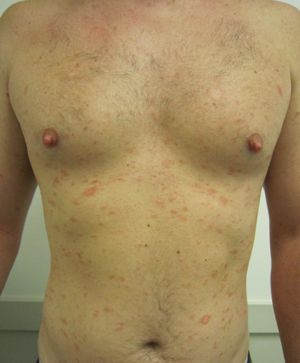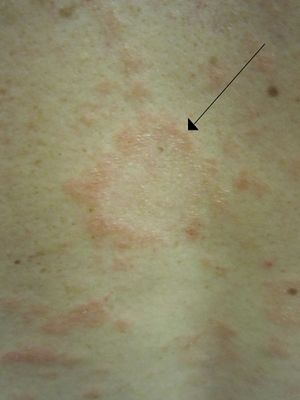We need you! Join our contributor community and become a WikEM editor through our open and transparent promotion process.
Pityriasis rosea
From WikEM
Contents
Background
- Mild inflammatory exanthem
- May be caused by HHV 6 and 7
- 70% preceded by URI [1]
- Most common 10-35yr old
- Not contagious
- Spontaneous resolution occurs within 4-12wk
Evaluation
- Begins with single, "herald," patch (salmon-colored, fine scaling)
- 1-2 weeks prior to generalized eruption
- Larger lesion (Herald Patch) that resembles the later smaller lesions
- Typically on the abdomen
- Secondary maculopapular rash with plaques following Langer Lines ("Christmas tree" pattern)
- Typically follows rip distribution
- Pruritus can be moderate to severe
- Consider RPR or VDRL to rule out syphilis
Differential Diagnosis
- Psoriasis
- Tinea corporis
- Usually not as widespread
- Pityriasis versicolor
- Also has fine scaling but KOH is diagnostic
Rash
- Acute generalized exanthematous pustulosis
- Allergic reaction
- Aphthous stomatitis
- Atopic dermatitis
- Cellulitis
- Chickenpox
- Chikungunya
- Coxsackie
- Dermatitis herpetiformis
- Drug rash
- DRESS syndrome
- Erysipelas
- Erythema multiforme
- Exfoliative erythroderma
- Henoch-schonlein purpura
- Hives
- Impetigo
- Measles
- Miliaria (Heat Rash)
- Necrotizing fasciitis
- Pellagra
- Petechiae & Purpura
- Poison Oak, Ivy, Sumac
- Psoriasis
- Pityriasis rosea
- Scabies
- Seborrheic dermatitis
- Serum Sickness
- Smallpox
- Shingles
- Stevens-Johnson syndrome and toxic epidermal necrolysis
- Tinea capitus
- Tinea corporis
- Vitiligo
Management
- Lasts 8 to 12 weeks[2]
- Reassurance about the self-limited nature
- Natural sunlight may speed up resolution
- Pruritus[3]
- Antihistamine, topical steroids
- Triamcinolone 0.1% - Adults
- Hydrocortisone 1% - children)
- Other
- Zinc oxide
- Calamine lotion
- Systemic steroids are generally not recommended.
- Antihistamine, topical steroids
- Rash or pruritus beyond 12 weeks: reconsider original diagnosis
- Consider biopsy to confirm the diagnosis
Disposition
- Discharge
References
- ↑ Sharma PK, Yadav TP, Gautam RK, Taneja N, Satyanarayana L (2000). "Erythromycin in pityriasis rosea: A double-blind, placebo-controlled clinical trial". Journal of the American Academy of Dermatology 42 (2 Patient 1): 241–4. PMID 1064267
- ↑ Richard P. Usatine and Jennifer Krejci-Manwaring: Rakel: Textbook of Family Medicine, 8th ed., Saunders 2011, (Ch) 33:p720
- ↑ Richard P. Usatine and Jennifer Krejci-Manwaring: Rakel: Textbook of Family Medicine, 8th ed., Saunders 2011, (Ch) 33:p720



